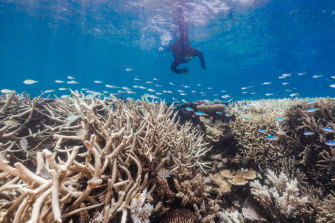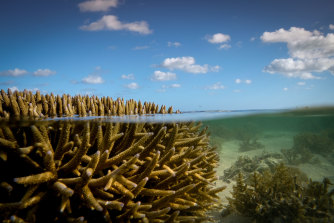An independent Commonwealth agency has delayed the release of a crucial report on coral bleaching on the Great Barrier Reef until after the federal election, raising questions about the politicisation of scientific processes.
The Great Barrier Reef Marine Park Authority (GBRMPA) confirmed on March 18 that there had been severe and widespread bleaching to 60 per cent of the corals along a 500-kilometre stretch of individual reefs that together make up the massive ecosystem.
Coral bleaching on Stanley Reef, south of Townsville, which occurred in a late summer heatwave in March. Credit:Australian Marine Conservation Society, Harriet Spark
The aerial surveys were completed by March 25. In previous mass bleaching events, the results were published within two weeks.
The survey will show precisely where corals have bleached within the 350,000-square-kilometre Great Barrier Reef Marine Park. This information is crucial because individual reefs that have bleached multiple times are less likely to survive.
GBRMPA was praised by scientists when it confirmed the bleaching event as it happened in March. The bleaching was revealed during a series of aerial surveying flights up and down the reef.
However, with an election looming on May 21, a report typically published to show the physical extent and severity of bleaching will not be published until after the poll.
The Sydney Morning Herald and The Age has confirmed the survey results have been finalised.
However, a GBRMPA spokesman said the report had been delayed and “it’s not likely to go out now until after the election”.
“The Reef Summer Snapshot 2021-22 was due to be released several weeks ago but has been delayed. It’s the official report released annually that summarises how the reef has fared over summer and features the aerial surveys,” the spokesman said.
The most recent bleaching occurred during a late summer heatwave across Far North Queensland. There have been five mass bleaching events – in 2002, 2016, 2017, 2020 and 2022 – but this was the first during a La Nina weather event, which is typically cooler than average.
Lizard Island, north of Cairns, is showing corals beginning to bleach amid sustained warm waters.Credit:Lyle Vail/Australian Museum via WWF
Bleaching occurs when the sea surface temperature is too hot for too long, causing corals to expel the algae living in their tissues and turn white. Bleaching itself does not mean corals are dead. The corals can recover if sea surface temperatures returned to normal quickly enough.
Professor Terry Hughes, the founding director of the ARC Centre of Excellence for Coral Reef Studies at James Cook University, said it was “disappointing” the survey results had not yet been published.
Hughes conducted aerial surveys during the past four mass bleaching events, which he published through another science agency, the Australian Institute of Marine Science (AIMS). He published results from surveys within two weeks of the flights being completed.
GBRMPA took responsibility for the surveys when he retired.
“They have clearly made the decision to hold on to that information, which is disappointing,” Hughes said. “Should they have the map out by now? The answer is yes. What’s the benefit of hiding it?”
Hughes explained that GBRMPA could swiftly publish a map with red and green dots plotting out the location of where corals had and had not died due to bleaching, while more nuanced reports to show the gradients of bleaching could come later.
“It does take more work to produce a refined map with other colours with orange and yellow dots – we usually delay that until we can publish in a scientific journal,” he said.
GBRMPA chief scientist Dr David Wachenfeld in March spoke extensively to media about the bleaching. He detailed in real-time what had been observed from the survey flights, including the severity and extent of bleaching.
Bleaching events are now frequent on the Great Barrier Reef.Credit:Eddie Jim
WWF head of oceans Richard Leck said “GBRMPA did an excellent job keeping Australians informed in the lead up to the last coral bleaching event”.
“It’s vital that they continue to deliver accurate and timely updates about the reef’s health after a mass coral bleaching event is declared,” Leck said.
University of Queensland senior lecturer Dr Selina Ward said the delay in publishing the survey results was “appalling”.
“People have a right to know now,” Ward said. “How can we think it’s not political interference when all the other results came out in a timely fashion?”
When asked about the release of the survey results, the Coalition campaign headquarters said in a statement the “timing is up to the discretion of those agencies”.
GBRMPA said in a statement that along with AIMS and CSIRO it was “working to release soon the annual Summer Reef Snapshot 2021-22”.
This report will include “the results of aerial surveys in the Summer Reef Snapshot provides readers important context which helps when interpreting the data”.
The Coalition has been criticised for not releasing another major study, the State of the Environment report, until after the election. Environment Minister Sussan Ley said she would comply with the statutory requirement to release the report within 15 business days of it being tabled in parliament, but that meant it could be published after the election.
The federal and Queensland governments have committed a total of $4 billion for reef conservation since 2019, including $580 million to improve water quality over the next decade by working with landholders to reduce erosion, sediment, fertiliser and pesticide runoff. It has committed more than $200 million to remove crown of thorns starfish and tackling illegal fishing since 2020.
Bleaching is forecast to reduce global coral cover by 95 per cent under 2 degrees of global warming, and 70 per cent under 1.5 degrees.
Cut through the noise of the federal election campaign with news, views and expert analysis from Jacqueline Maley. Sign up to our Australia Votes 2022 newsletter here.
Most Viewed in Politics
From our partners
Source: Read Full Article


